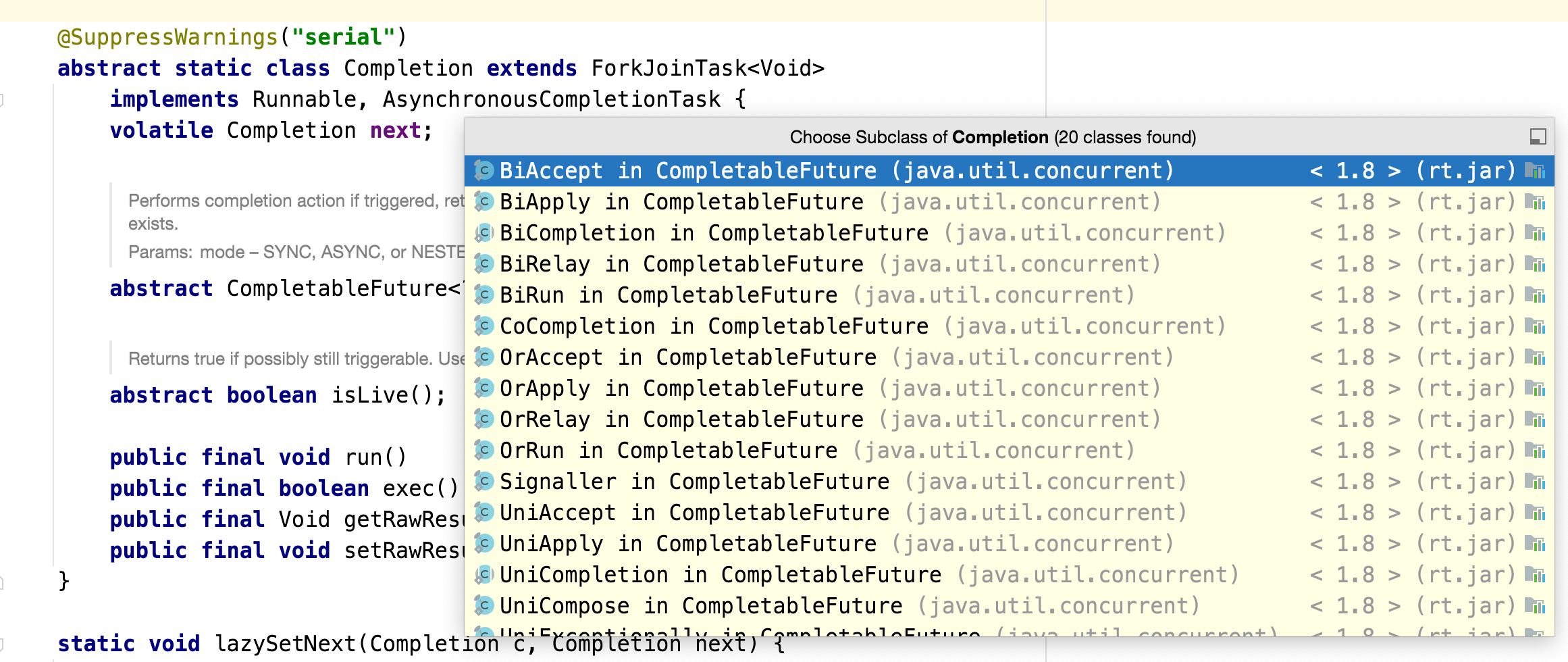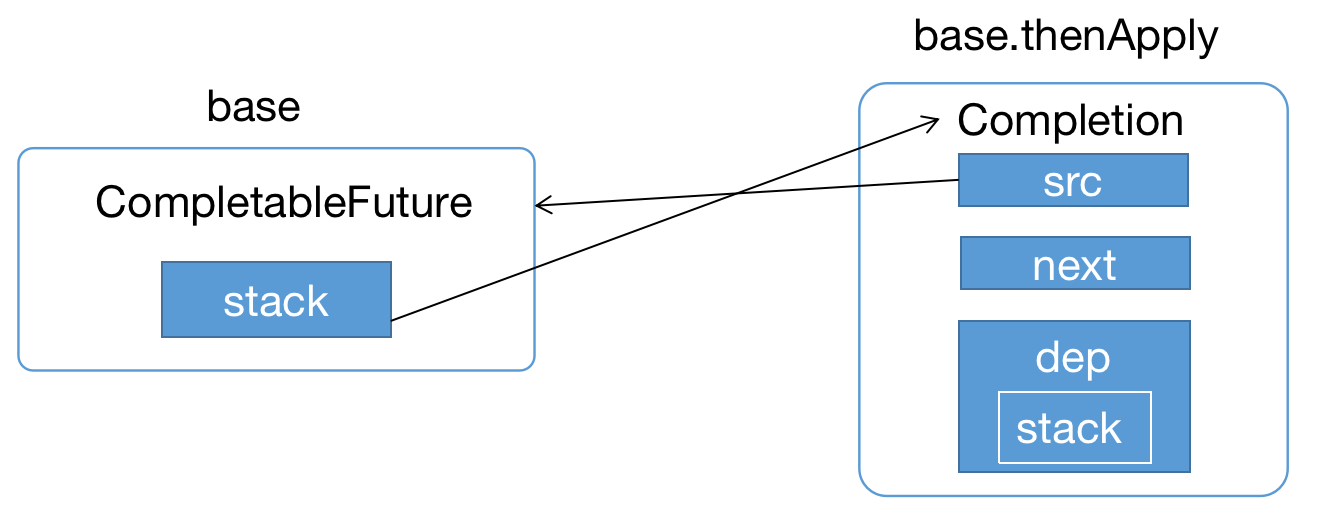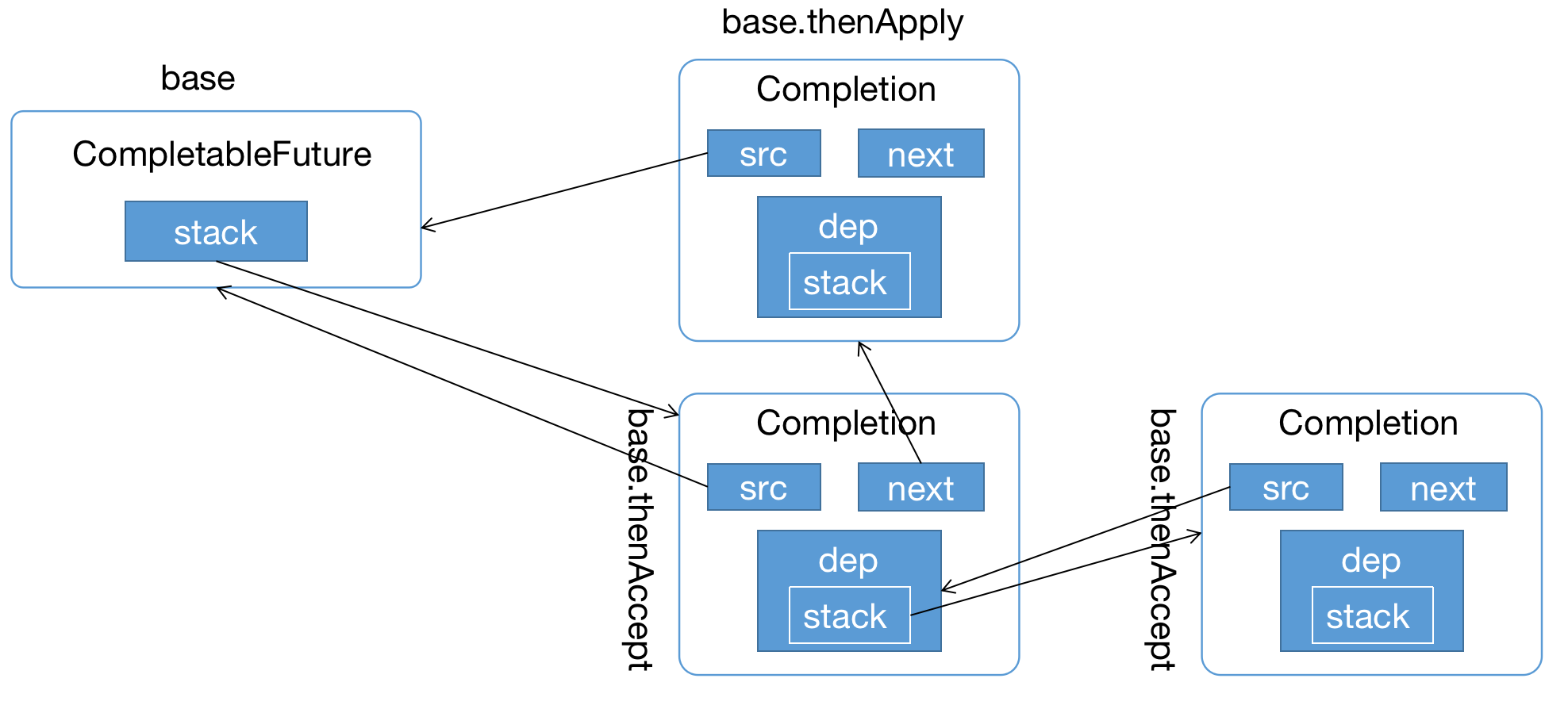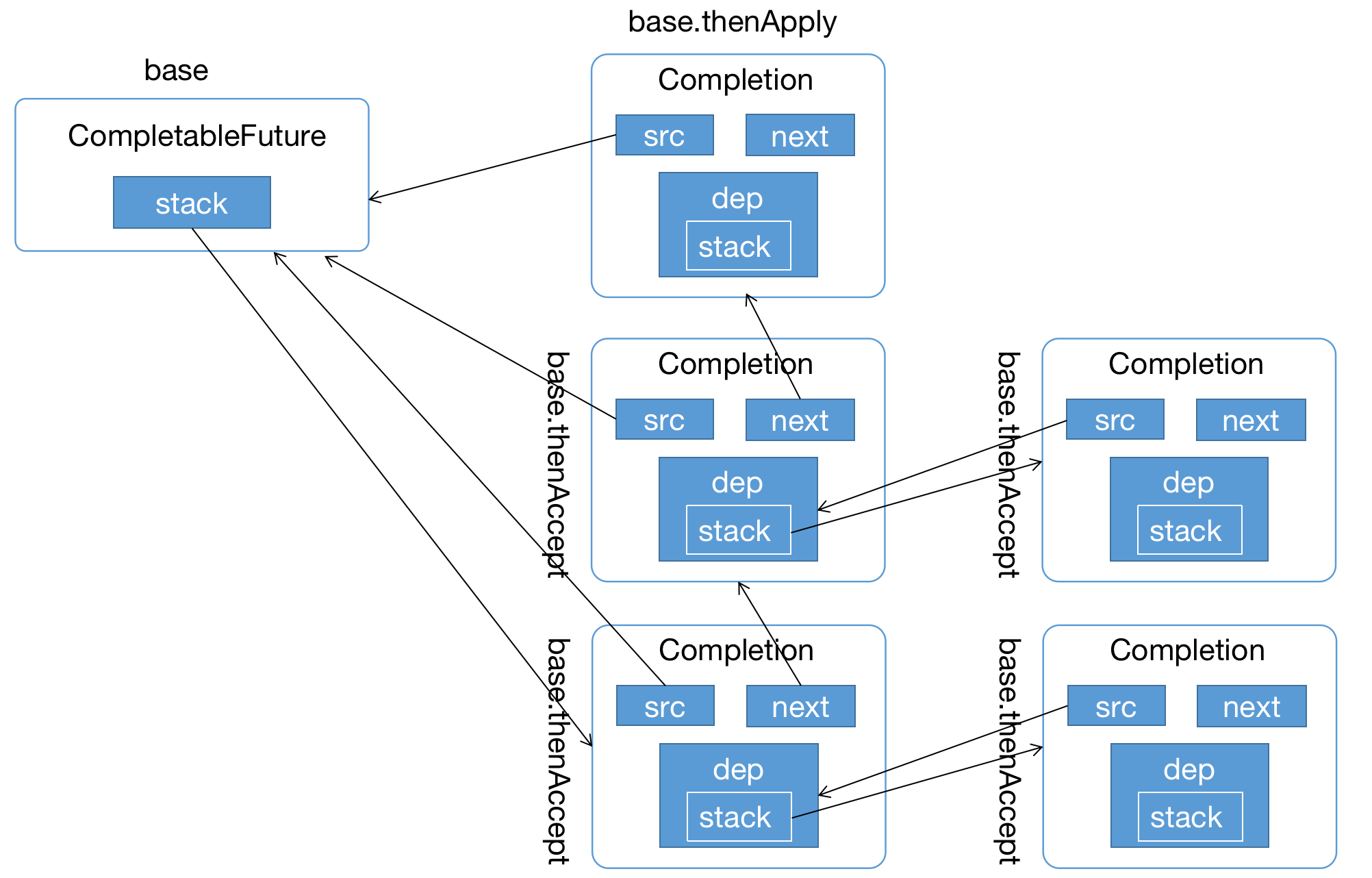图解CompletableFuture源码
前言
关于CompletableFuture源码解析部分,整体上感觉还是写比较难的,不过为了推广到团队还是要好好搞一下的,我还是希望大家看到这边文章能学到点什么,废话不多说开始吧。
属性部分
首先看属性部分,我觉得可以从全貌了解他的整体的数据结构,后续我们看到一些操作的时候,也不会产生疑问,算是一种先整体后部分的思想。
打开CompletableFuture源码以后我们首先看到是下面两个核心的关键属性result和stack,关于这两个属性也有核心的注释,result可能是返回的结果集,也可能是包装的AltResult,stack这个数据暴露出了CompletableFuture的整体的结构是一个栈。
volatile Object result; // Either the result or boxed AltResult volatile Completion stack; // Top of Treiber stack of dependent actions
接下来我们看下Completion的情况,Completion是一个抽象类,分别实现了Runnable、AsynchronousCompletionTask接口,继承了ForkJoinPoolTask类,而ForJoinPoolTask抽象类又实现了Future接口,因此Completion实际上就是一个Future。

img
在Completion类中还有一个非常重要的成员属性,结合我们上面看到的CompletableFuture的stack属性,整好能验证CompletableFuture是一个链表的一个数据结构,Completion中的next保存了栈中下一个元素的引用,而CompletableFuture中的stack永远指向栈顶,至于是不是栈我们可以看下后续方法是如何操作的。
volatile Completion next;
关于Completion类其实是一个抽象类,还有很多的实现,如下图,后续我们看到具体的实现的时候再来细化实现类。

img
核心方法源码解析
首先我们来看两个测试用例,
@Test public void test1() throws ExecutionException, InterruptedException { CompletableFuture<String> base = new CompletableFuture<>(); CompletableFuture<String> future = base.thenApply(s -> s + " 2").thenApply(s -> s + " 3"); base.complete("1"); System.out.println(future.get()); } @Test public void test2() throws ExecutionException, InterruptedException { CompletableFuture<String> base = new CompletableFuture<>(); CompletableFuture<String> future = base.thenApply(s -> s + " 2").thenApply(s -> s + " 3"); future.complete("1"); System.out.println(future.get()); }
执行这两个测试用例以后,我们会发现最终的结果的是不一致的,这里base和future对象,分别调用complete()和get()方法的排列组合,最终导致结果就发生了变化,是不是很神奇,接下来我们就来看看thenApply相关源码部分。
thenApply
关于thenApply的使用,CompletableFuture提供了类似的三个方法,以Async结尾的表示异步执行,如果传入Executor则以指定线程池执行,否则默认使用的线程池是ForkJoinPool。
public <U> CompletableFuture<U> thenApply( Function<? super T,? extends U> fn) { return uniApplyStage(null, fn); } public <U> CompletableFuture<U> thenApplyAsync( Function<? super T,? extends U> fn) { return uniApplyStage(asyncPool, fn); } public <U> CompletableFuture<U> thenApplyAsync( Function<? super T,? extends U> fn, Executor executor) { return uniApplyStage(screenExecutor(executor), fn); }
我们重点关注的thenApply的方法,整体的源码如下:
public <U> CompletableFuture<U> thenApply( Function<? super T,? extends U> fn) { return uniApplyStage(null, fn); } private <V> CompletableFuture<V> uniApplyStage( Executor e, Function<? super T,? extends V> f) { if (f == null) throw new NullPointerException(); 1.创建一个新的CompletableFuture对象 CompletableFuture<V> d = new CompletableFuture<V>(); if (e != null || !d.uniApply(this, f, null)) { 2. 构建UniApply e代表线程池 d 代表新的CompletableFuture this 代表当前 f 代表方法 这个时候 UniApply 内部的所有的引用都处于为null的状态 UniApply<T,V> c = new UniApply<T,V>(e, d, this, f); 3. c其实就是Completion对象,被push到栈中 push(c); 4. 尝试执行c c.tryFire(SYNC); } 5. 这个d会一直返回到调用thenApply的地方,后续的链式调用会作用在这个d上面 return d; } @SuppressWarnings("serial") static final class UniApply<T,V> extends UniCompletion<T,V> { Function<? super T,? extends V> fn; UniApply(Executor executor, CompletableFuture<V> dep, CompletableFuture<T> src, Function<? super T,? extends V> fn) { 2.1 向上执行 super(executor, dep, src); this.fn = fn; } } abstract static class UniCompletion<T,V> extends Completion { Executor executor; // executor to use (null if none) CompletableFuture<V> dep; // the dependent to complete CompletableFuture<T> src; // source for action UniCompletion(Executor executor, CompletableFuture<V> dep, CompletableFuture<T> src) { 2.2 dep就是新创建的d src就是当前的this this.executor = executor; this.dep = dep; this.src = src; } }
关于执行第2步的时候,构建的对象如下图, src和dep都是空的CompletableFuture,next为Null,这里我们会发现所有的都是继承Completion对象,最终所有都是构建都可以理解为Completion对象;

img

image.png
关于执行第3步的时候,构建的UniApply对象的内容完成压栈的操作,将CompletableFuture的stack属性指向Completion对象;

img

image.png
接下来看第4步操作,尝试执行Completion;
@SuppressWarnings("serial") static final class UniApply<T,V> extends UniCompletion<T,V> { Function<? super T,? extends V> fn; UniApply(Executor executor, CompletableFuture<V> dep, CompletableFuture<T> src, Function<? super T,? extends V> fn) { super(executor, dep, src); this.fn = fn; } final CompletableFuture<V> tryFire(int mode) { 4.1 d新创建的 a(也是c中的src) 就是原来的 CompletableFuture<V> d; CompletableFuture<T> a; 4.2 如果uniApply执行成功,则会进到下面的postFire调用 否则返回null 如果返回null,就要等待以后的主动complete来再次触发 if ((d = dep) == null || !d.uniApply(a = src, fn, mode > 0 ? null : this)) return null; 4.5 tryFire成功后,会把以下几个属性设为null,表面此Completion已经完成任务, 变成dead状态 dep = null; src = null; fn = null; 4.6 出栈 return d.postFire(a, mode); } } final <S> boolean uniApply(CompletableFuture<S> a, Function<? super S,? extends T> f, UniApply<S,T> c) { Object r; Throwable x; 4.3 如果a(也是c中的src)没有准备完成,那result是空,这里就会直接返回false if (a == null || (r = a.result) == null || f == null) return false; tryComplete: if (result == null) { if (r instanceof AltResult) { if ((x = ((AltResult)r).ex) != null) { completeThrowable(x, r); break tryComplete; } r = null; } try { if (c != null && !c.claim()) return false; @SuppressWarnings("unchecked") S s = (S) r; 4.4 如果r不为空,则会作为f的输入参数,f的输出则成为当前CompletableFuture的完成值 completeValue(f.apply(s)); } catch (Throwable ex) { completeThrowable(ex); } } return true; }
第5步返回d, 这个d会返回到调用thenApply的地方,后续的链式调用会作用在这个d上面,接下来我们可以看到base对象就是我们构建好的第一个链;

img
这里我们可以猜测后续的执行thenApply的方法,也就是执行完成test1的第二行代码,生成的结构如下图:

img
接下来我们验证一下,我们可以发现和我们猜想一致;

img
当我们的代码执行到test1的第3行的时候,也就是complete方法,该方法也就是为了解决我们执行tryFire执行失败后动作,源码如下:
public boolean complete(T value) { boolean triggered = completeValue(value); postComplete(); return triggered; } final void postComplete() { 1. this表示当前的CompletableFuture, 也就是我们base CompletableFuture<?> f = this; Completion h; 2. 判断stack是否为空 或者如果f的栈为空且不是this则重置 while ((h = f.stack) != null || (f != this && (h = (f = this).stack) != null)) { CompletableFuture<?> d; Completion t; 3. CAS出栈 if (f.casStack(h, t = h.next)) { if (t != null) { 4.出栈的h不是最后一个元素,最后一个元素直接执行7即可 if (f != this) { 5. 如果f不是this,将刚出栈的h, 入this的栈顶 我猜测这个地方大家会有迷惑 pushStack(h); continue; } h.next = null; 6. detach } f = (d = h.tryFire(NESTED)) == null ? this : d; 7.调用tryFire } } }
对于postComplete()方法可以理解为当任务完成之后,调用的一个后完成方法,主要用于触发其他依赖任务,也就是完成出栈的操作,关于第4、5步和的疑惑,这里我先说一下,这里的原因是每次调用产生的Completion并不在同一个stack中,接下来我们来看一个复杂的案例,可能大家就比较明白了;
复杂案例
@Test public void test3() throws ExecutionException, InterruptedException { CompletableFuture<String> base = new CompletableFuture<>(); CompletableFuture<String> future = base.thenApply(s -> { log.info("2"); return s + " 2"; }); base.thenAccept(s -> log.info(s + "3-1")).thenAccept(aVoid -> log.info("3-2")); base.thenAccept(s -> log.info(s + "4-1")).thenAccept(aVoid -> log.info("4-2")); base.complete("1"); log.info("base result: {}", base.get()); log.info("future result: {}", future.get()); }
首先看下输出,我们可以看到基本上是按照4-3-2-1的顺序输出的,证明CompletableFuture整体上是一个栈的结构,接下来我们就图解下这一过程;

img
当代码执行完第7行的时候我们得到的是这样的结构:

img

image.png
代码执行完第8行的时候,结构是这样的:

img

image.png
执行完第9行的时候,结构是这样的:

img

image.png
到这里就构成我们整个的调用链路,这个时候我们可以想明白为什么出栈的时候要判断下f != this了吧,因为内部又嵌套层栈的结构,构成了一个图状;
当代码执行到第10行的时候,就开始出栈,按照4-3-2-1的顺序输出,到这里这部分内容就讲解完成了。
参考以下内容:
结束
欢迎大家点点关注,点点赞! 